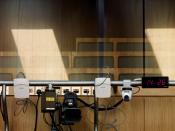On December 6, 2005, the House Judiciary Committee Chairman James Sensenbrenner (R-Wisconsin) introduced the Border Protection, Antiterrorism, and Illegal Immigration Control Act of 2005 (H.R. 4437). The bill contains a wide range of border and interior enforcement provisions, including mandating the use of an electronic verification system for new hires and existing employees, criminalizing unlawful presence and other immigration status violations, and enhancing technology at the border. The provisions are discussed in greater detail below. The Committee held a "markup" (i.e. it considered the bill) on December 8, 2005 and reported the bill favorably, by a 23-15 vote. The House of Representatives is expected to debate and vote on the bill today or tomorrow. As of this writing, the House Rules Committee has received at least 128 amendments to H.R. 4437, 16 of which will be given time for debate on the Floor.
Over the past several weeks, House Leadership and the Chairman of the House Judiciary Committee have expressed a desire to address the issue of immigration enforcement before considering any guest worker proposals.
Opponents to this approach have stated that the U.S. needs a comprehensive reform of its immigration system, and enforcement alone will not solve the problem of illegal migration. H.R. 4437's fast-paced movement through the legislative process is a reflection of the position of House Leadership and the Judiciary Committee.
Employer Sanctions/Worksite EnforcementH.R. 4437, Title VII proposes a new electronic employment verification system that is very similar to the current Basic Pilot program. Title VII would mandate, two years after enactment of the new system, that an employer query the system for confirmation of employment eligibility within three days of hiring a new employee. It also retains much of the current I-9 system. An amendment at the markup on December 8th clarified that electronic I-9 verification is still available.
The provisions in this title would require the Department of Homeland Security (DHS) to investigate social security fraud if 1) an employer submits the same social security number two or more times, or 2) multiple employers submit the same social security number. Another amendment that the Committee adopted at the markup would require DHS to initiate an investigation within 10 days of suspecting fraud.
Title VII further modifies the current good faith defense by adding the requirement that, if an employer does not make an electronic inquiry within three days of the new hire, the good faith defense would not apply. In case of system failure, the employer would have until the end of the first day that the system is up and running to make an inquiry. The good faith defense would not apply if the system does not provide a confirmation by the end of the three-day period. In the event of a final non-confirmation, the employer would be required to either terminate employment, or keep the employee and inform DHS.
One requirement in this bill that causes some business groups concern is that existing employees would also be required to undergo the employment verification process. Government offices, critical infrastructure facilities, and persons working on government sites would be subject to verification three years after the new system is enacted. Six years after enactment, all U.S. employees would be subject to verification. Recruiters and referrers would also be required to use the system to verify employees before sending them to job sites.
Border Protection, Antiterrorism, and Illegal Immigration Control Act of 2005 (H.R. 4437)





